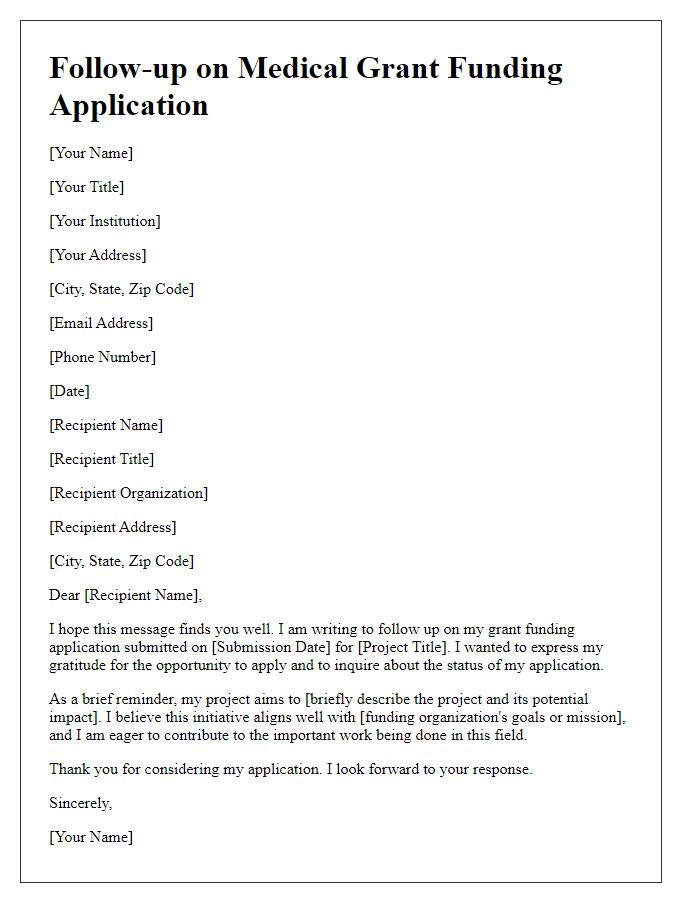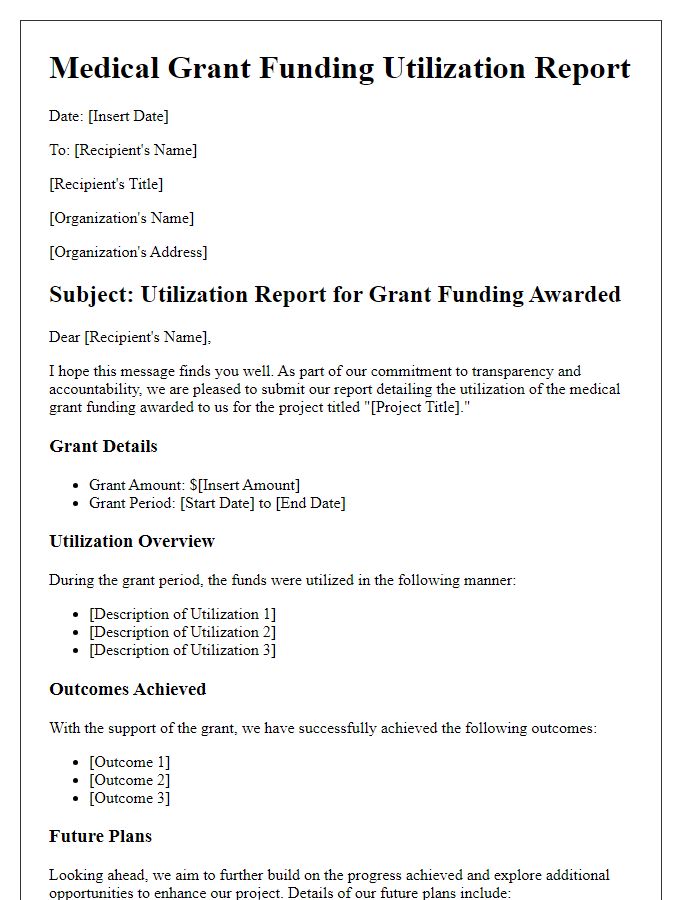Are you seeking funding for a medical project that could make a real impact? Crafting the perfect letter to secure that grant is essential, and it can feel daunting at times. In this article, we'll walk you through the key components of a compelling letter template designed specifically for medical grant funding. So, grab your notepad and let's dive into the details that can help you succeed!

Purpose and Objective
Medical grant funding, aimed at advancing healthcare research, plays a crucial role in supporting innovative projects. The primary purpose of this funding is to facilitate breakthroughs in medical science by providing necessary financial resources to researchers and institutions. Objectives include enhancing patient outcomes through the development of novel therapies and technologies, addressing public health challenges, and improving the understanding of diseases. Funding typically focuses on priority areas such as cancer research, regenerative medicine, and mental health initiatives, with goals to translate findings into practical applications that benefit communities globally.
Background and Significance
Medical research grants play a crucial role in advancing healthcare, fostering innovations in treatment, and improving patient outcomes. Historical data shows that in 2022, approximately $50 billion was allocated to medical research funding in the United States alone, highlighting the significance and financial support available for groundbreaking projects. With rising global health concerns like cancer, cardiovascular diseases, and infectious diseases, the urgency for targeted research has never been more pronounced. Institutions such as the National Institutes of Health (NIH) and the World Health Organization (WHO) emphasize a multidisciplinary approach, integrating technology, biology, and clinical expertise to tackle these pressing health challenges. The significance of this grant cannot be overstated; it provides essential resources necessary for pioneering studies that hold the potential to lead to transformative medical interventions and improved health policies, consequently benefiting populations worldwide.
Methodology and Approach
The methodology utilized in the proposed study revolves around a multi-phase approach designed to investigate the effects of a novel therapeutic intervention for chronic pain management. This study will involve a randomized controlled trial (RCT) with a sample size of 200 participants, recruited from pain management clinics in Chicago, Illinois. Baseline assessments will include validated questionnaires such as the Visual Analog Scale (VAS) and the Brief Pain Inventory (BPI) to measure pain intensity and interference. The intervention group will receive the novel therapy while the control group will receive standard care. Follow-up assessments will be conducted at 3, 6, and 12 months to evaluate pain relief and quality of life, using metrics like the McGill Pain Questionnaire. Data analysis will employ statistical methods, including Analysis of Variance (ANOVA), to determine the efficacy of the intervention. This structured approach aims to provide robust evidence on the novel therapy's impact, ultimately contributing to improved pain management protocols.
Budget and Resource Allocation
A comprehensive budget is crucial for a successful medical grant funding proposal, detailing the financial requirements for the project's implementation. Research personnel costs, such as salaries for principal investigators and research assistants, are often significant, accounting for 40-60% of the total budget. Equipment purchases, including specialized medical instruments like MRI machines or laboratory systems, can range from $10,000 to over $1 million, depending on the project's scope. Consumable supplies, such as reagents and test samples, should also be estimated, contributing an additional 15-25% of the overall budget. Facility costs, including overhead expenses related to the institutional infrastructure, usually represent 20-30% of funding requests. Allocating funds for patient recruitment and community outreach, essential for clinical studies, often requires an investment of 5-10% of the budget. Lastly, setting aside funds for data analysis software, typically $500 to $5,000, ensures proper management of collected data, leading to meaningful results and impactful findings.
Impact and Outcomes
Medical grant funding plays a crucial role in advancing healthcare initiatives, particularly in research aimed at discovering innovative treatments for diseases. Funding allocations, often ranging from $50,000 to several million dollars depending on the project scope, significantly impact patient care outcomes. For instance, clinical trials funded through grants can lead to FDA-approved therapies that improve survival rates for conditions such as cancer, where advancements have increased five-year survival rates from approximately 50% in the 1970s to over 70% in recent years. Furthermore, these grants facilitate collaborations between research institutions, such as Johns Hopkins University in Baltimore and Stanford University in California, fostering a multidisciplinary approach that accelerates the translation of lab findings into practical applications. Ultimately, successful funding can result in tangible benefits to communities, such as increased access to advanced medical treatments and enhanced public health education.













Comments